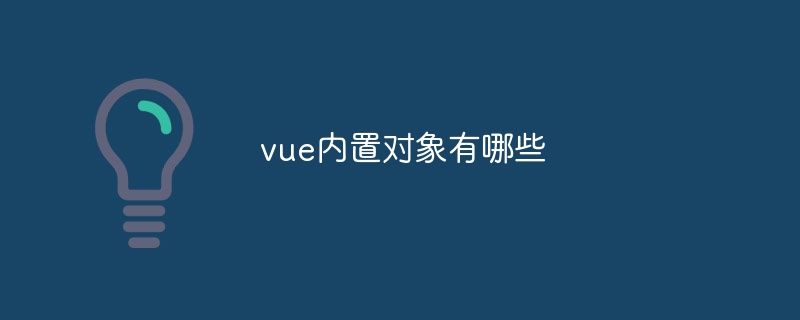Home >Web Front-end >Front-end Q&A >What are the built-in objects of Vue?
What are the built-in objects of Vue?
- 百草Original
- 2023-11-08 16:52:161756browse
Vue built-in objects include Vue, Vue instance, data, el, options, parent, root, children, slots, scopedSlots, refs, isServer, attrs and listeners. Vue.js is a progressive JavaScript framework for building user interfaces. In Vue.js, there are some built-in objects or global APIs that can be used to create and manage Vue applications.

The operating system for this tutorial: Windows 10 system, DELL G3 computer.
Vue.js is a progressive JavaScript framework for building user interfaces. In Vue.js, there are some built-in objects or global APIs that can be used to create and manage Vue applications. The following are some common Vue built-in objects:
1. Vue: The Vue object is the main entry point of the Vue framework. It is a global object in which Vue applications can be created and configured. The Vue object provides some methods, such as new Vue() to create a Vue instance, and some options, such as data, methods, computed, etc., to define the application's data and behavior.
2. Vue instance: The instance object created through the new Vue() or Vue.extend() method is the core of the Vue application. It contains some properties and methods, such as el, data, options, parent, $root, etc. Through these properties and methods, you can access and control the data and behavior of your Vue application.
3. data: data is an object used to store data of Vue instances. It can contain some properties and values, which can be used in the application. For example, $data can contain a property called name, which can be accessed and displayed in the template.
4. el: el is a DOM element used to store the root DOM node of the Vue instance. It is a jQuery or Zepto object through which DOM elements can be accessed and manipulated.
5. Options: options is an object used to store options for Vue instances. It can contain some properties and values, which can be used in the application. For example, $options can contain a property called template, which can be used in templates.
6. parent: parent is a Vue instance object, used to access the parent instance of the current instance. If the current instance has no parent instance, $parent is null.
7. Root: root is a Vue instance object, used to access the root instance of the current instance. If the current instance is the root instance, $root is the current instance itself.
8. children: children is an array used to store child instances of the current instance. Child instance objects can be accessed and controlled through $children.
9. Slots: slots is an object used to access the slot content of the current instance. It can contain some key-value pairs, each key-value pair represents a slot name and corresponding content. Slot contents can be accessed and controlled through $slots.
10. scopedSlots: scopedSlots is an object used to access the scoped slot content of the current instance. It can contain some key-value pairs, each key-value pair represents a scope slot name and corresponding content. You can access and control scoped slot contents through $scopedSlots.
11. refs: refs is an object used to access the reference object of the current instance. It can contain some key-value pairs, each key-value pair represents a reference name and the corresponding reference object. Reference objects can be accessed and controlled through $refs.
12. isServer: isServer is a Boolean value used to determine whether the current instance is running in a server-side rendering (SSR) environment. If the current instance is running in a server-side rendering environment, $isServer is true; otherwise, it is false.
13. attrs: attrs is an object used to store the attributes (Attributes) of the current instance. It can contain some key-value pairs, each key-value pair represents an attribute name and the corresponding attribute value. Attribute objects can be accessed and controlled through $attrs.
14. listeners: listeners is an object used to store the event listeners of the current instance. It can contain some key-value pairs, each key-value pair represents an event name and the corresponding event listener function. Event listener objects can be accessed and controlled through $listeners.
In addition to the common built-in objects mentioned above, Vue also provides many other built-in objects and methods, such as Vue Router, Vuex, etc. for building complex single-page applications (SPA).
The above is the detailed content of What are the built-in objects of Vue?. For more information, please follow other related articles on the PHP Chinese website!

